Pump Stations
LASA’s wastewater collection system is comprised of 44 strategically located pump stations that play a critical role in transporting sewage from homes and businesses to various treatment facilities. These pump stations direct flow to LASA-operated treatment plants located in Washington Boro and West Earl Township, as well as to the City of Lancaster’s treatment facility. The size and capacity of LASA’s pump stations vary significantly, ranging from small-scale stations handling as little as 2,500 gallons per day (gpd) to large-scale facilities capable of moving up to 8.5 million gpd.
Pumping stations are essential components of the sewer collection system, particularly in regions where the natural topography does not support gravity-fed flow. In such areas, pump stations lift wastewater to a higher elevation, enabling it to continue its journey through the system toward a treatment facility. Without these pump stations, it would be impossible to provide consistent and reliable sewer service to many low-lying or unevenly contoured areas within the service region. By incorporating pumping technology into the network, LASA ensures that all customers receive effective wastewater collection, regardless of geographical challenges.
